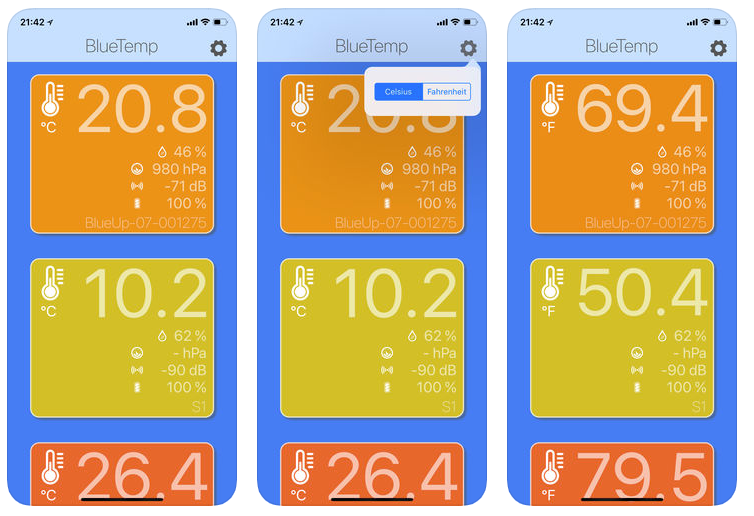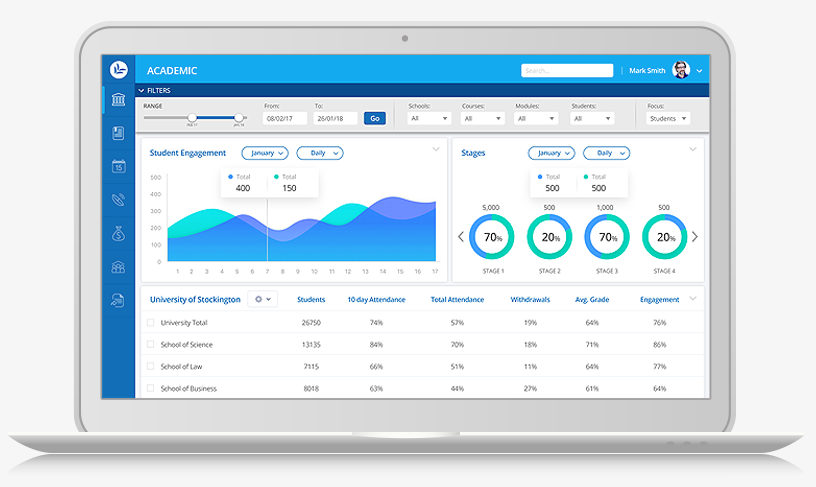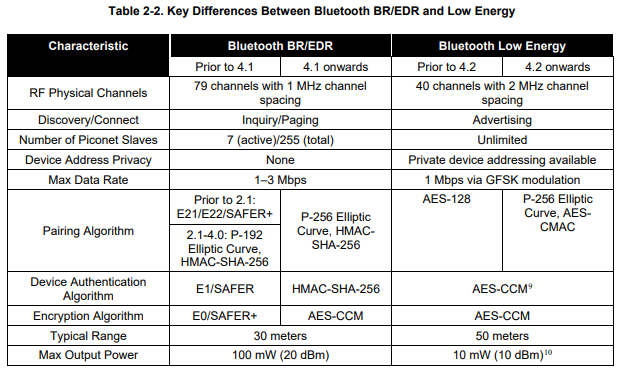There’s an useful new free iOS app BlueTemp that shows displays Bluetooth sensor data.

It works with BlueUp, Minew S1 and Forecum 201 beacons showing temperature, humidity and pressure, depending on what the respective beacon supports.
iBeacon, Eddystone, Bluetooth, IoT sensor beacons, apps, platforms
There’s an informative article at LEDs Magazine on Bluetooth Mesh expert addresses questions about connected SSL. The expert is Simon Slupik, CTO of Silvair and chair of the Mesh Working Group at the Bluetooth SIG.
While the article explains the use of Bluetooth mesh in the context of lighting, many of the concepts are equally as applicable in other applications of mesh. The article covers robustness, interference immunity, low energy, scalability, antennas and security.
Read about Beacons and the Bluetooth Mesh
SEAtS Software, a student attendance monitoring solution has a new article that takes a look at options for implementing student attendance monitoring. It compares using iBeacons, mag stripe card readers, GPS, WiFi and QR codes.

The article concludes that iBeacons are best because they are easy to install, provide the best accuracy, are affordable, easy to use and reduce administration time.
Read about Beacons in Education
In our previous post on Apple WWDC on the ‘Find my’ feature we explained how the use of others’ phones for finding your devices is much like Tile (and other tracking beacons). However, there’s evidence that Apple might also be creating their own, separate, Tile-like device. 9to5Mac also have some further speculations.
It’s also interesting that Apple are changing the API for looking for beacons. CLBeaconRegion has become CLBeaconIdentityConstraint. The functionality currently remains the same in that you can filter by UUID/major/minor. However, the renaming of the API to make it more generic suggests it might eventually also be used for something else which might be the Apple tag.
While devices such as the Tile are great, when finding items remotely, they assume lots of people have them for someone else’s Tile app to see your tile. While the Tile network is large at 15 million trackers it will never be large enough to reliably find things. Apple has a much greater reach to make such a scheme more successful. Tracking things such as your lost car or dog become far more feasible.
An observation is that Google Android has a substantially greater reach offering Google the opportunity to offer something similar, more reliable (due to sheer number of devices) but more open as they did with Bluetooth Eddystone vs iBeacon. Taking this idea further, it’s a shame there isn’t an open Bluetooth tracking system or standard, for example, championed by the Bluetooth SIG.
September 2019 Update: It’s looks like Apple will be using UWB rather than Bluetooth making the solution more accurate and more proprietary. If true, it will eventually compete with Bluetooth Direction Finding.
May 2020 Update: The device will be called AirTag.
The Go programming language, also known as Golang, is a simpler version of C without dynamic memory allocation making it easier and safer to use. The language was invented and is in use at Google.
The go-bluetooth library extends Go to allow it to communicate with Bluetooth devices. Your can pair, discover, communicate via GATT and manage the underlying hci/Bluetooth service.
U-Blox has a useful article on Seven reasons why Bluetooth is perfect for the Industrial IoT, echoing some of our observations on Bluetooth LE on the Factory Floor. The article explains why Industrial Internet of Things (IIoT) systems and networks should consider Bluetooth as the communications infrastructure.
As U-Blox mentions, there’s predicted to be 5.2 billion Bluetooth device shipments by 2022. This data is from the latest Bluetooth SIG/ABI research:
Read about Beacons in Industry and the 4th Industrial Revolution (4IR)
While some people were hoping for an ‘iBeacon version 2’ and there were rumours of a new Apple ultra wideband locating system, neither were announced at WWDC 2019. Instead, the Bluetooth news centred around the ability to use Bluetooth to find Apple devices, even when they aren’t online and even when they aren’t nearby.
Some news outlets have described this as a Bluetooth mesh network made up of all other iOS/Mac devices which is misleading and will lead to unfortunate confusion with the official Bluetooth SIG mesh. Instead, as Apple described, the system is much like the tracker ’tile’ type beacons that have apps that report in all seen beacons to a central server. If someone else’s device sees your device then you can find your device.
The difference to tile-like beacons is that the servers belong to Apple, the Bluetooth advertising is proprietary (and hence anonymous to eavesdroppers) and devices are acting as beacons. It’s interesting how, or if, Apple has done this without impacting both your iPhone battery life and the battery life of all iPhones scanning for beacons. The Bluetooth advertising must be very infrequent.
Privacy conscious people might also observe that this also gives a new way for Apple to know the location of Apple devices and proximity between devices. We wonder whether this will be ‘on’ by default for all users, opt in or opt out? Privacy matters aside, always knowing the proximity between Apple devices allows Apple to provide for some interesting possible future usecases.
UPDATE: There’s a new article in Wired explaining how the mechanism is end to end encrypted. This means Apple doesn’t know where your device is and, by implication, won’t be able to implement the possible ‘future usecases’ I alluded to.
In our post on compatibility we explained how Bluetooth LE connection problems are more likely to be with Android rather than the devices (beacons) with which they are communicating.
If you are experiencing such problems you can try clearing your Android Bluetooth cache:
Settings
Select Application Manager
Display system apps (swipe left/right or choose from the menu in the top right corner)
Select Bluetooth
Select Storage
Tap Clear Cache
Restart the phone
Note that these menus are not available on the latest versions of (vanilla, non-OEM) Android because Google has unhelpfully removed access to system apps.
EAO AG, a company specialising in human machine interfaces, has a new train passenger interface that provides phone charging and information services.
The information services use iBeacon locating to allow train operating companies to provide added value services such as journey information, ticket validation and refreshments requests. The wireless USB phone charging fits onto seats and the iBeacon is detected in mobile apps.
“The iBeacon in each Passenger Interface also transmits a code to the passenger’s travel app, while the cloud translates the code into a carriage and seat number, making seat reservations easier to track and helping make passengers’ journeys more connected than ever”
Read about Beacons in Transportation
We occasionally get asked about the specifics of Bluetooth LE security. This is usually when a project has security requirements or needs to formally document things such as cryptography schemes and vulnerabilities.
The U.S. Department of Commerce National Institute of Standards and Technology (NIST) has an informative Guide to Bluetooth Security (pdf) that provides information on the security features of Bluetooth, vulnerabilities, threats and extensive recommendations.
The following table provides an overview of Bluetooth LE compared ‘Classic’ Bluetooth Basic Rate/Enhanced Data Rate (BR/EDR) protocol:

Bluetooth LE 4.2 and later uses ECDH P-256 Elliptic Curve public key cryptography for protection against passive eavesdropping and man in the middle (MITM) during pairing.
While it’s good for projects to be aware of the underlying mechanisms and their limitations, we find that, in practice, security threats and weaknesses tend to be related more to how Bluetooth LE is used (by software) on a particular project rather than Bluetooth implementation itself.